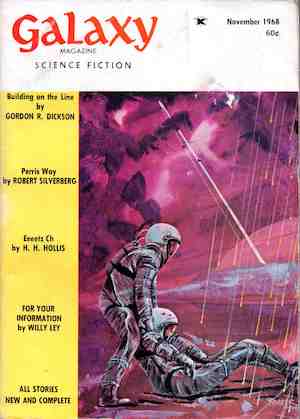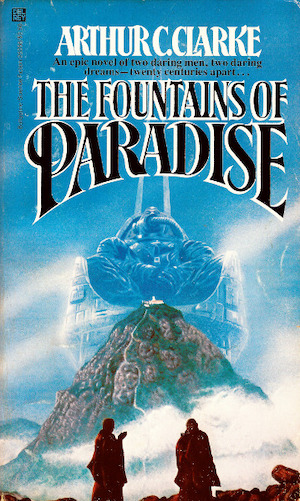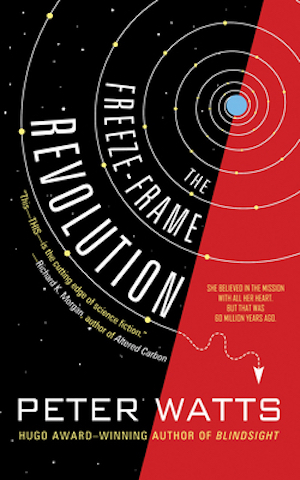I was somewhat bewildered when, after years of significant construction-related transit disruptions, Waterloo Region’s Ion light rail system actually began transporting people from one location to another. We all know that large infrastructure projects are aspirational, interminable, and expensive. Who ever heard of them being finished? Nevertheless, the completion and ongoing use of the LRT argues that sometimes the system fails and large projects actually succeed in their goals.
Science fiction, being less limited by cruel practicality, abounds with successful and ambitious infrastructure projects. Consider the following four examples.
Building on the Line by Gordon R. Dickson (1968)

Man’s glorious interstellar destiny depends on linesmen like Clancy and Plotch risking their lives to construct transmit stations on hostile alien worlds. XN-4010 is more challenging than most outpost worlds. Cold enough to freeze oxygen, XN-4010 is home to an enigmatic race of hobgoblins implacably hostile to the off-world visitors. Men working under those conditions need all the friends they can get. Too bad for Clancy that all he has is the annoying Plotch.
A hobgoblin attack strands the pair and leaves Plotch mostly dead. Dutiful Clancy sets out on the long journey back to the Terran homebase on XN-4010. It’s not at all clear which will be the greatest impediment: a) the distance he needs to cover on foot while carrying Plotch, b) the hobgoblins, or c) the cutting-edge, unreliable equipment with which all linesman are saddled.
This novelette reminds me of a Robert Sheckley story that is being played utterly straight.
Readers may wonder why, if the natives are so hostile, humans insist on building a transmit station on XN-4010. It’s one part “the humans have little control over which anchor worlds can be reached” and one part “it was 1968, and the idea that locals should have a say about how a more powerful culture should use their land was controversial when it was a subject of discussion at all.”
Fountains of Paradise by Arthur C. Clarke (1979)

Vannevar Morgan’s groundbreaking bridge spanned the Strait of Gibraltar, joining Atlantic Europe to Africa for the first time since the Zanclean flood. Morgan’s next project will utterly eclipse the 14-kilometer Gibraltar bridge. He must construct a vertical suspension bridge from the Earth’s surface more than 36,000 kilometers into space itself. If he is successful, he will revolutionize space travel. If unsuccessful, he will join visionaries like Thomas Andrew, William Mulholland, and Leon Moisseiff in disgrace.
There are straightforward impediments to overcome. The structure demands materials of stupendous strength. Construction requires methods that haven’t been invented yet. Some suitable location must be found to anchor the orbital tower. This last presents Morgan with what could be his greatest challenge, a political one: The best anchor site is occupied a Buddhist temple whose master has no intention of granting access to the tower project. Eminent domain is not an option. What’s a poor visionary to do?
As you may know, this was one of two novels about orbital towers that were published back to back. Of the two, I prefer the Clarke, not least because, unlike the Sheffield, it didn’t rely on a method of delivering the anchor end of the tower to Earth that would make any safety engineer faint.
The Freeze-Frame Revolution by Peter Watts

The starship Eriophora has circled the Milky Way, leaving five thousand superluminal wormhole gates in its wake. The scale of the project is prodigious, both in space and in time. It has been sixty-five million years since Eriophora launched. Whatever entities now use the faster-than-light network the starship laboriously constructs are very likely not human.
Eriophora’s human crew are infrequently needed, occasionally woken from cold-sleep to deal with problems beyond the limited (but reliable) intelligence of the ship’s AI. Chafing at their endless servitude, human minds turn to escape. But how can people who wake one week out of every thousand years outwit a relentless master with all the time in the world to methodically monitor its human servants?
Ah, good old Peter Watts, about whom I once observed “Whenever I find my will to live becoming too strong, I read Peter Watts.” However, this story isn’t as bleak as many other Watts stories.
The Long Way to a Small, Angry Planet by Becky Chambers (2014)

New members in the Galactic Commons, humans aren’t yet a valued member species. Humans’ most spectacular accomplishment to date is nearly killing their own homeworld. The jury is still out as to whether accepting humans into the Commons was a mistake or not. Humans are therefore ideal expendables, suitable for the Commons’ dangerous, low status jobs.
The good ship Wayfarer expands galactic infrastructure by punching wormholes from one galactic region to another. The galaxy is filled with hazards. The diverse crew has to somehow overcome their intrinsic differences and work as a team. Failure means not merely insolvency but possible death as well.
The Galactics are remarkably judgmental about humans, given some of the planet-altering shenanigans some member species have engaged in. It seems that while the various member species may be very different from each other in form and culture, many of them share a capacity for hypocrisy.
***
As has been noted before, epic infrastructure projects are a common subject for science fiction authors. These four are a very small sample. If by chance I overlooked one of your favorites, please mention them in comments below.
In the words of fanfiction author Musty181, four-time Hugo finalist, prolific book reviewer, and perennial Darwin Award nominee James Davis Nicoll “looks like a default mii with glasses.” His work has appeared in Interzone, Publishers Weekly and Romantic Times as well as on his own websites, James Nicoll Reviews (where he is assisted by editor Karen Lofstrom and web person Adrienne L. Travis) and the 2021, 2022, and 2023 Aurora Award finalist Young People Read Old SFF (where he is assisted by web person Adrienne L. Travis). His Patreon can be found here.










